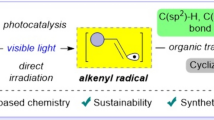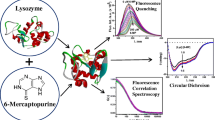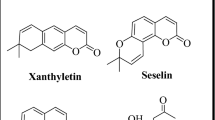Abstract
The photophysical behaviour of 7-mercapto-4-methylcoumarin (C-SH) and derivatives has been studied in different solvents. In contrast to 7-hydroxy-4-methylcoumarin, C-SH shows poor emission, but high fluorescence when the thiol is alkylated. The origin and character of the lowest singlet states are discussed, specifically proposing that the thione-like C=S resonance form plays a key role in excited state deactivation in C-SH.
Similar content being viewed by others
References
M. S. T. Gonçalves, Fluorescent Labeling of Biomolecules with Organic Probes, Chem. Rev., 2009, 109, 190–212.
K. G. Reddie, W. H. Humphries, C. P. Bain, C. K. Payne, M. L. Kemp, and N. Murthy, Fluorescent Coumarin Thiols Measure Biological Redox Couples, Org. Lett., 2012, 14, 680–683. Y. Chen H. R. Liu H. S. Liu M. Cheng P. Xia K. D. Qian P. C. Wu C. Y. Lai Y. Xia Z. Y. Yang S. L. Morris-Natschke K. H. Lee, Antitumor agents 292. Design, synthesis and pharmacological study of S- and O-substituted 7-mercapto- or hydroxy-coumarins and chromones as potent cytotoxic agents, Eur. J. Med. Chem., 2012, 49, 74-85.
W. Ji, N. Li, D. Chen, X. Qi, W. Sha, Y. Jiao, Q. Xu, and J. Lu, Coumarin-containing photo-responsive nanocomposites for NIR light-triggered controlled drug release via a two-photon process, J. Mater. Chem. B, 2013, 1, 5942–5949. P. Klan T. Solomek C. G. Bochet A. Blanc R. Givens M. Rubina V. Popik A. Kostikov J. Wirz, Photoremovable protecting groups in chemistry and biology: reaction mechanisms and efficacy, Chem. Rev., 2013, 113, 119-191.
J. S. S. Demelo, R. S. Becker, and A. L. Macanita, Photophysical Behavior of Coumarins as a Function of Substitution and Solvent - Experimental-Evidence for the Existence of a Lowest Lying (1)(Eta,Pi(Asterisk)) State, J. Phys. Chem., 1994, 98, 6054–6058.
J. R. Heldt, J. Heldt, M. Stori, and H. A. Diehl, Photophysical Properties of 4-Alkylcoumarin and 7-Alkoxycoumarin Derivatives - Absorption and Emission-Spectra, Fluorescence Quantum Yield and Decay Time, Spectrochim. Acta, Part A., 1995, 51, 1549–1563.
D. Jacquemin, E. A. Perpete, G. Scalmani, M. J. Frisch, X. Assfeld, I. Ciofini, and C. Adamo, Time-dependent density functional theory investigation of the absorption, fluorescence, and phosphorescence spectra of solvated coumarins, J. Chem. Phys., 2006, 125, 164324.
B. D. Wagner, The Use of Coumarins as Environmentally-Sensitive Fluorescent Probes of Heterogeneous Inclusion Systems, Molecules., 2009, 14, 210–237.
C. L. Tung, H. Y. Lam, J. Xu, and X. Li, A fluorogenic probe for recognizing 5-hydroxylysine inspired by serine/threonine ligation, Chem. Commun., 2014, 50, 5298–5300. H. Woo Y. You T. Kim G.-J. Jhon W. Nam, Fluorescence ratiometric zinc sensors based on controlled energy transfer, J. Mater. Chem., 2012, 22, 17100-17112. E. González-García V. Helaine G. Klein M. Schuermann G. A. Sprenger W.-D. Fessner J.-L. Reymond, Fluorogenic Stereochemical Probes for Transaldolases, Chem.–Eur. J., 2003, 9, 893-899.
G. I. N. Trendafilova, A. J. A. Aquino, and H. Lischka, Excited state properties off 7-hydroxy-4-methylcoumarin in the gas phase and in solution. A theoretical study, J. Phys. Chem. A, 2005, 109, 11860–11869. N. Nizomov A. U. Kholov A. A. Ishchenko V. V. Ishchenko V. P. Khilya, Electronic structure and spectral fluorescence properties of umbelliferone and herniarin, J. Appl. Spectrosc., 2007, 74, 626-634. J. Donovalova M. Cigan H. Stankovicova J. Gaspar M. Danko A. Gaplovsky P. Hrdlovic, Spectral Properties of Substituted Coumarins in Solution and Polymer Matrices, Molecules, 2012, 17, 3259-3276. C. M. Krauter J. Mohring T. Buckup M. Pernpointner M. Motzkus, Ultrafast branching in the excited state of coumarin and umbelliferone, Phys. Chem. Chem. Phys., 2013, 15, 17846-17861. T. Sakurai H. Mizoguchi S. Yamada H. Inoue, Proton-transfer reactions between 7-hydroxycoumarin and tertiary amines. Formation of the ground-state tautomer anion, Ber. Bunsenges. Phys. Chem., 1996, 100, 505-507. W. R. Sherman E. Robins, Fluorescence of Substituted 7-Hydroxycoumarins, Anal. Chem., 1968, 40, 803-805.
J. S. de Melo, and P. F. Fernandes, Spectroscopy and photophysics of 4-and 7-hydroxycoumarins and their thione analogs, J. Mol. Struct., 2001, 565, 69–78.
M. Gonzalez-Bejar, M. Frenette, L. Jorge, and J. C. Scaiano, 7-Mercapto-4-methylcoumarin as a reporter of thiol binding to the CdSe quantum dot surface, Chem. Commun., 2009, 22, 3202–3204. M. Dübner T. N. Gevrek A. Sanyal N. D. Spencer C. Padeste, Fabrication of Thiol–Ene “Clickable” Copolymer-Brush Nanostructures on Polymeric Substrates via Extreme Ultraviolet Interference Lithography, ACS Appl. Mater. Interfaces., 2015, 7, 11337-11345.
S. G. Schulman, and L. S. Rosenberg, Tautomerization Kinetics of 7-Hydroxy-4-Methylcoumarin in the Lowest Excited Singlet-State, J. Phys. Chem., 1979, 83, 447–451.
N. J. R. Turro, V. Ramamurthy, and J. C. Scaiano, Modern Molecular Photochemistry of Organic Molecules, University Science Publishers, New York, N.Y., 2010.
J. S. deMelo, R. S. Becker, F. Elisei, and A. L. Macanita, The photophysical behavior of 3-chloro-7-methoxy-4-methylcoumarin related to the energy separation of the two lowest-lying singlet excited states, J. Chem. Phys., 1997, 107, 6062–6069.
L. Cisse, A. Djande, M. Capo-Chichi, F. Delatre, A. Saba, A. Tine, and J.-J. Aaron, Revisiting the photophysical properties and excited singlet-state dipole moments of several coumarin derivatives, Spectrochim. Acta, Part A., 2011, 79, 428–436.
Y. Liu, J. Ding, R. Liu, D. Shi, and J. Sun, Revisiting the electronic excited-state hydrogen bonding dynamics of coumarin chromophore in alcohols: Undoubtedly strengthened not cleaved, J. Photochem. Photobiol., A, 2009, 201, 203–207. G.-J. Zhao K.-L. Han, Hydrogen Bonding in the Electronic Excited State, Acc. Chem. Res., 2012, 45, 404-413.
B. Valeur, and M. N. Berberan-Santos, in Molecular Fluorescence, Wiley-VCH Verlag GmbH & Co. KGaA, 2012, pp. 109–140.
G.-J. Zhao, and K.-L. Han, Early Time Hydrogen-Bonding Dynamics of Photoexcited Coumarin 102 in Hydrogen-Donating Solvents: Theoretical Study, J. Phys. Chem. A., 2007, 111, 2469–2474.
X. Liu, J. M. Cole, P. G. Waddell, T. C. Lin, J. Radia, and A. Zeidler, Molecular origins of optoelectronic properties in coumarin dyes: toward designer solar cell and laser applications, J. Phys. Chem. A, 2012, 116, 727–737. A. P. Demchenko, Advanced fluorescence reporters in chemistry and biology I fundamentals and molecular design, Springer, Berlin, Germany, 2010., M. Frenette C. Coenhart J. C. Scaiano, Mapping Acid-Catalyzed Deprotection in Thin Polymer Films: Fluorescence Imaging Using Prefluorescent 7-Hydroxycoumarin Probes, Macromol. Rapid Commun., 2004, 25, 1628-1631. Z. Wu Z. Li L. Yang J. Hanb S. Han, Fluorogenic detection of hydrogen sulfide via reductive unmasking of o-azidomethylbenzoyl-coumarin conjugate, Chem. Commun., 2012, 48, 10120-10122.
Acknowledgments
The Natural Sciences and Engineering Research Council of Canada supported this work through its Discovery and graduate scholarships programs. Thanks are due to the Canada Research Chairs program for an award to J. C. S. and to summer student Phillip Campbell for his help with some measurements.
Author information
Authors and Affiliations
Corresponding author
Rights and permissions
About this article
Cite this article
Lanterna, A.E., González-Béjar, M., Frenette, M. et al. Photophysics of 7-mercapto-4-methylcoumarin and derivatives: complementary fluorescence behaviour to 7-hydroxycoumarins. Photochem Photobiol Sci 16, 1284–1289 (2017). https://doi.org/10.1039/c7pp00121e
Received:
Accepted:
Published:
Issue Date:
DOI: https://doi.org/10.1039/c7pp00121e




